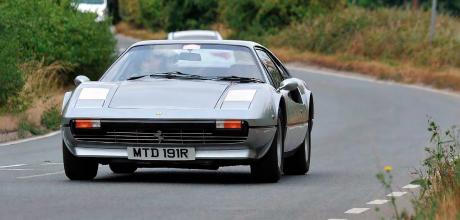1977 Ferrari 308 GTB Vetroresina with a fully glassfibre body by Scaglietti
Lightweight and rare, the short-lived 308 GTB Vetroresina is the only plastic-bodied road car ever made by Ferrari. How special does it feel to drive?
Story by Tim Pitt
Photography by Michael Ward
Seeing the Light FERRARI 308 GTB VETRORESINA
What makes the plastic-bodied 308 so special?
We are all being urged to use less plastic, but today I’ve made an exception. The Ferrari 308 GTB I’m driving is an early Vetroresina version, with a fully glassfibre body by Scaglietti.

Lightweight, small and still going strong after 46 years, it makes an unorthodox case for sustainability. While this particular 308 has lived to a ripe old age, the same wasn’t true of the Vetroresina in general. Launched in 1975, Ferrari’s first – and to date only – glassfibre road car lasted until 1977 before production switched to steel bodywork. During those two years, Maranello says 808 cars were made, although many experts put the number at 712. Whatever the truth, with more than 12,000 examples of the 308 GTB and GTS made in total, the Vetroresina is a rare beast. What this car isn’t, however, is a homologation special, even though it has elements of exotic, motorsport-inspired pedigree – including a dry sump. The 308 did enjoy some success in Group 4 and Group B rallying thanks to Michelotto, but all that happened after 1978. Like the turbocharged 288 GTO that followed, this was very much a road car first.
“ Get beyond 4500rpm and the V8 really comes alive. What it lacks in performance is amply compensated for in rich analogue feedback ”

Ferrari’s reasons for using glassfibre aren’t well documented – perhaps it caught wind of the rival Lotus Esprit, also revealed at the Paris Motor Show in 1975 – but ‘adding lightness’ was certainly a consideration. Hung on a tubular steel chassis, the plastic body and panels – excepting the aluminium front lid – resulted in a dry weight of just 1090kg. Add around 100kg for the ‘DIN’ kerb weight figure, including fluids and a 90 percent tank of fuel, and this V8-engined Ferrari is still lighter than many of today’s three-cylinder superminis. Significantly, the Vetroresina also weighs 150kg less than the steel-bodied 308. Fitted with a 255hp V8 that was still unfettered by emissions equipment, the result is the fastest 308 of all: Ferrari claimed 0-62mph in 6.7 seconds and a top speed of 157mph.
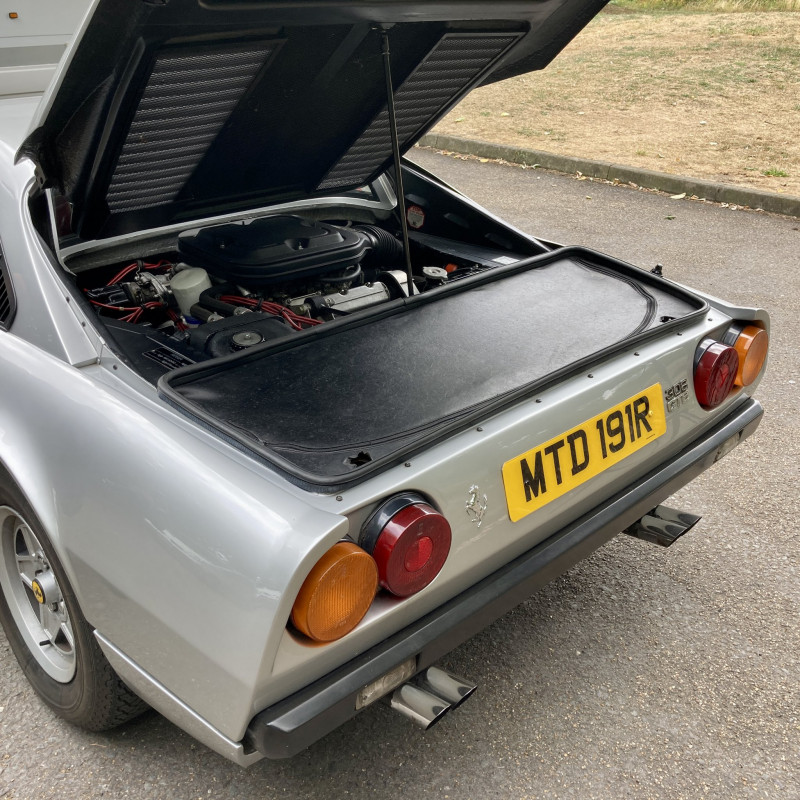
This shows just how ‘mid-engined’ the 308 GTB is. And how much luggage space it has (the full-width zip-up compartment behind). These early fibreglass cars have a dry sumped, carb-fed 3.0-litre V8 that makes about 250hp.
Another reason for choosing glassfibre may have been the rush to get this ‘junior’ Ferrari into production. Rewind to the early 1970s and the 308 GT4 – the effective replacement for the Dino 246 GT – was selling slowly, not helped by the oil crisis and its slightly awkward Bertone styling. Ferrari had to bolster its bottom line, and tooling up for a glassfibre body was quicker than using steel. Ironically, it was the added time that Carrozzeria Scaglietti needed to assemble each individual car – and the associated cost– that would seal the Vetroresina’s fate. Colin Sowter, owner of this stunning 1976 308 GTB in Argento Auteil, describes it as his “favourite car ever”. When your collection includes a stable of Ferrari Challenge race cars (348, 458 Italia, F430 and more), that’s high praise indeed. The owner of Superformance, which supplies parts for a huge variety of Ferrari models.
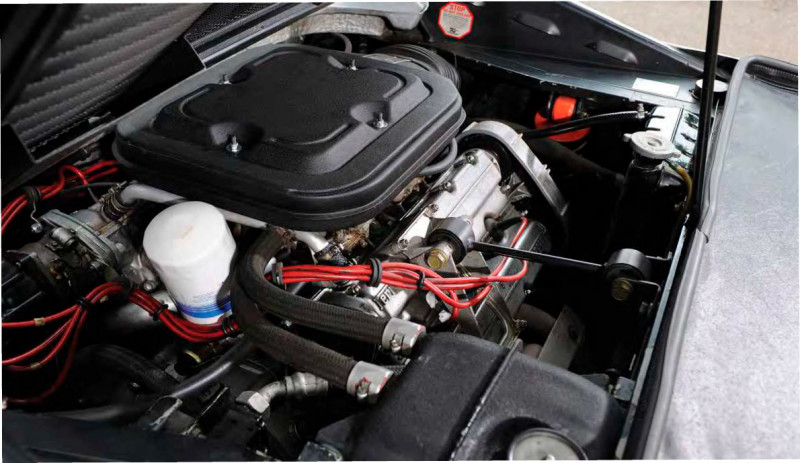
Amazingly, Colin bought his first 308 GTB – a Vetroresina – when he was just 18 years old. The princely £5500 he paid was around half the car’s cost when new. He’s owned the example you see here for 16 years and recently put it up for sale. “Then I decided I couldn’t bear to part with it,” he says with a smile. “The glassfibre cars are the pinnacle for me. I love the purity of their design, which predates all the aerodynamic appendages. And they’re really tactile to drive, with a fantastic exhaust note.”
We’ll come to driving shortly, but it’s worth taking a moment to stop and stare first. Combining sensuous curves with the wedginess that was alla moda in the 1970s, the 308 successfully bridges the gap between the dainty Dino 246 GT and the brawny Berlinetta Boxer. Forever made famous by a starring role in the 1980s crime drama, Magnum PI, it’s one of Pininfarina’s prettiest shapes. Besides, any car with pop-up headlights is automatically cool.
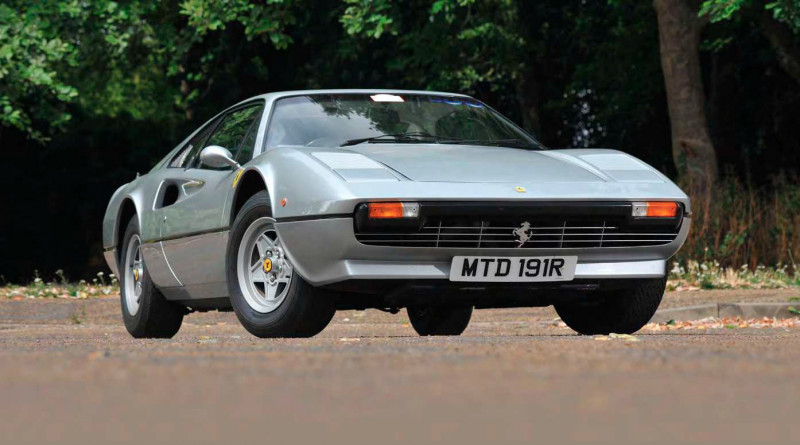
At first glance, the Vetroresina looks identical to any steel-bodied 308. Look closer, though, and you’ll spot the reversing lamps integrated into the rear bumper, rather than being part of Ferrari’s traditional round tail lights. There’s also an indentation where the top of the windscreen pillar joins the roof, plus standard 14-inch alloy wheels on bulbous 205/70 tyres (later cars had the option of 16-inch rims).
Lift the (surprisingly heavy) glassfibre engine lid and the transverse 2.9-litre V8 is wedged tight against the rear bulkhead. Clearly, Ferrari wanted to make the 308 GTB as ‘mid-engined’ as possible. The full-width boot is located behind, with a zip-up cover and enough space for a set of golf clubs, putting most modern supercars to shame and making the 308 practical enough for road trips and holidays.
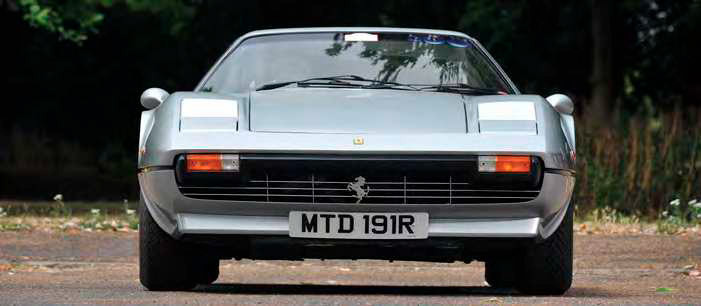
The cabin isn’t so spacious, and downright cramped for anyone over 6ft tall, but my modest 5ft 8in frame finds it very comfortable. Slim pillars and the vastamount of glass make it feel more spacious, too. Allround visibility is excellent, even if the Vitaloni California ‘bullet’ door mirrors (common on Italian cars of this era) are pretty hopeless. The only other ergonomic flaw is the hooded instrument binnacle, which reflects badly in the windscreen. It’s the reason why many 308s have dashboards covered in aftermarket flock or Alcantara.
You sit exotically low, hips thrust forward and arms outstretched, the Momo steering wheel slightly more horizontal than you might expect. The Veglia rev counter is redlined at close to 8000rpm and the speedo reads to 180mph. There are two supplementary gauges (oil temperature and clock) down by your left knee. The sliders and toggle switches on the centre console feel delicate, but the open-gate manual gearbox demands a firm shove when cold.
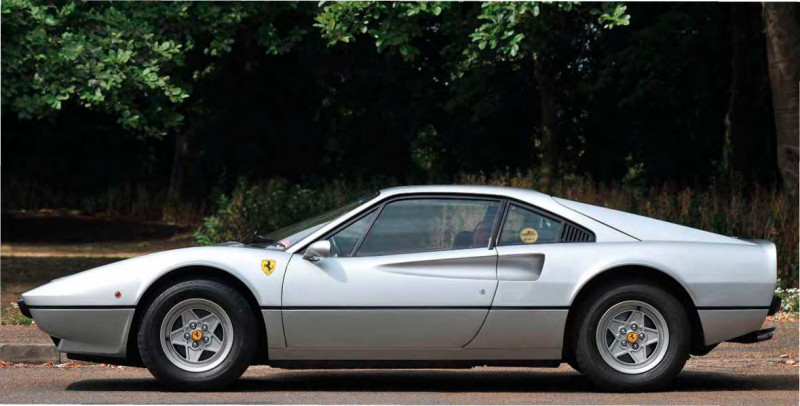
Colin’s car has a cassette player and air conditioning – both optional extras when the 308 GTB was new. However, even on a stuffy August afternoon, I’m happy just to lower the window and enjoy the gargle of four Weber 40DCNF carburettors and the crisp bark of the flat-plane crank. A feature of right-hand drive 308s with carbs (including all 154 Vetroresinas made in RHD) is a rubber pipe behind the driver’s side door scoop that feeds straight into the air cleaner. It’s like having V8 music pumped directly into your left ear.
This breathy induction growl, which becomes a hard-edged snarl as the revs rise, sounds like no other Ferrari I’ve driven. It instantly evokes a rally car soundtrack and is a huge part of the Vetroresina’s charm. However, it could certainly become wearing on long journeys. Ted Pearson, friend of Auto Italia and another long-term Vetroresina owner, told us he temporarily removed the air pipe to make his car quieter. Nonetheless, Ted has had some “absolutely joyous” drives during nearly 50,000 miles with his 308 GTB. “There’s a reason why I’ve owned it for so long,” he explains. “I enjoy it more than the F355 I had previously.”

You get the sense that Colin Sowter prefers this little 308 to modern Ferraris. “They’re such different experiences, there’s almost no comparison. You can’t drive modern Ferraris to an enjoyable level on the road.
The 308 offers great communication through the steering, plus surprisingly high levels of grip for the period. But if you exploit the performance, you do need to take the 1970s brakes into account.”
For me – piloting Colin’s car with due respect, rather than on the ragged edge – the brakes feel quite adequate. Indeed, the 308 GTB proves remarkably easy to drive, with smooth steering (power assistance wasn’t fitted or needed), modest dimensions and a supple ride on those tall tyres. The gearbox also becomes pleasingly slick once the oil has warmed through. Only its dog-leg first gear – located opposite reverse, with the other four ratios in an H-pattern – can feel a bit cumbersome in traffic.

Get beyond 4500rpm and the F106 V8 really comes alive. To modern sensibilities, the 308 can feel a bit floaty over bumps and undulations, but you soon learn to trust it, revelling in its artfully poised balance and the glorious rasp of its quad-tailpipe exhaust. What it lacks in performance – its 255hp, delivered at 7700rpm, is scarcely hot hatch territory today – is amply compensated for in rich analogue feedback. Ted is right: ‘joyous’ is the word.
For a long time, there was very little price difference between glassfibre and steel versions of the 308. That started to change around 20 years ago, as the market woke up to the rarity and added appeal of the Vetroresina. These early plastic cars now command a healthy premium, with the best examples advertised for well into six figures. In a society that sees plastic as cheap and disposable, that might seem expensive. However, when an equivalent Dino 246 GT is three times the price, this rather special Ferrari suddenly looks a bit of a bargain.
TECHNICAL SPECIFICATIONS FERRARI 308 GTB VETRORESINA
- ENGINE: 2927cc V8
- BORE X STROKE: 81mm x 71mm
- COMPRESSION RATIO: 8.8:1
- MAX POWER: 255hp at 7700rpm
- MAX TORQUE: 284Nm (210lb ft) at 5000rpm
- TRANSMISSION: Five-speed manual, rear-wheel drive
- SUSPENSION: Unequal-length wishbones, coil springs, telescopic dampers, anti-roll bars
- BRAKES: Hydraulic discs all round
- DIMENSIONS: 4230mm (L), 1720mm (W), 1120mm (H)
- WEIGHT: 1090kg (dry)
- MAX SPEED: 157mph
- 0-62MPH: 6.7sec

There’s nothing like a carbfed V8 singing behind you to make you feel joyous of a morning, if a little deaf. Great steering and grip by 1970s standards are offset by weak brakes. Open-gate ’box needs a brawny shove.Reversing lamps in rear bumper are one of the few giveaways that you’re looking at a Vetroresina.
You sit low, hips thrust forward, arms outstretched, the Momo wheel more horizontal than you expect


